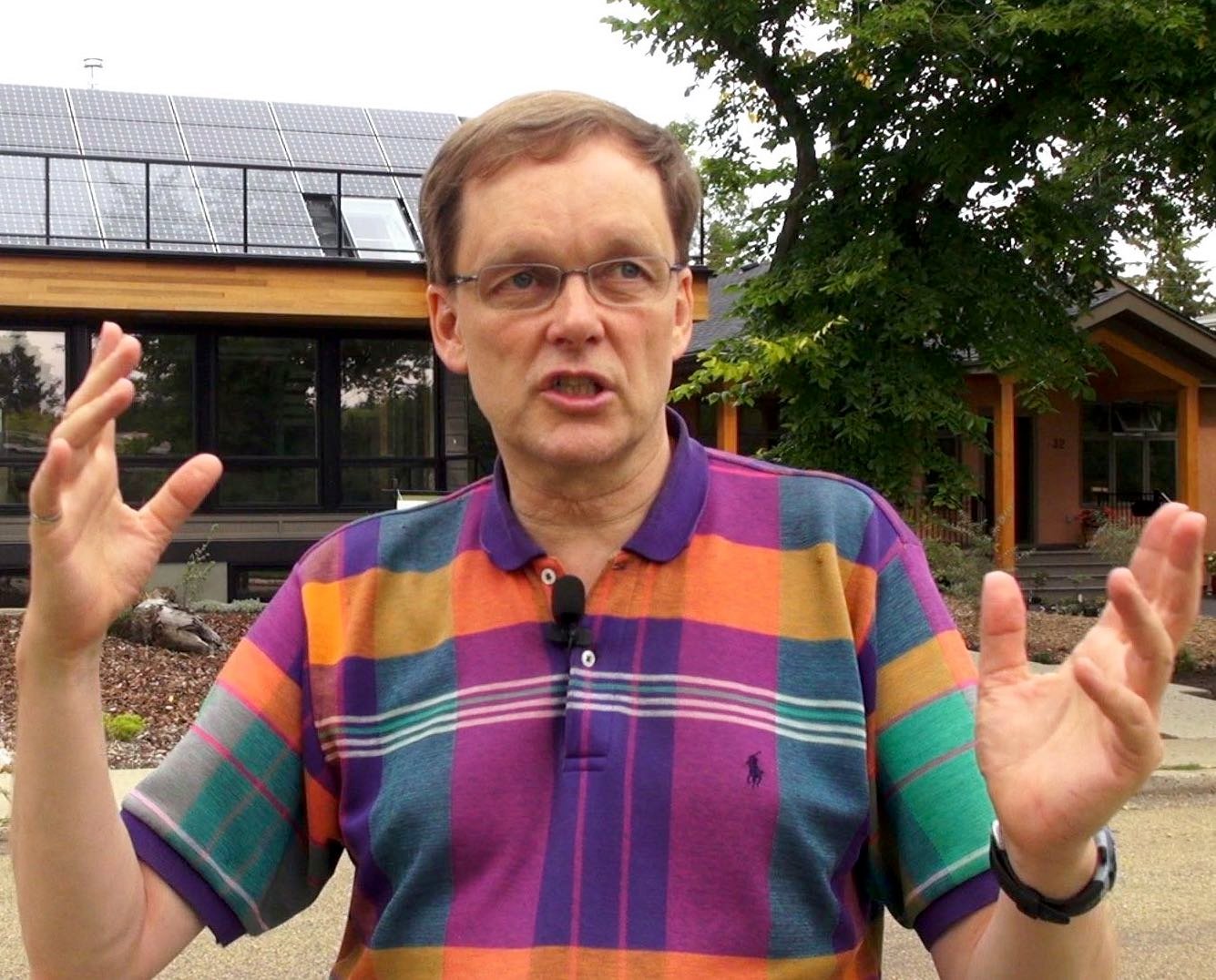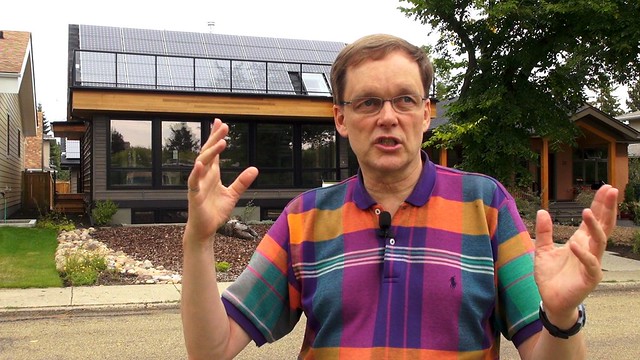By David Dodge
Gordon Howell is a solar pioneer. He installed the first grid-connected solar system in Western Canada on his home in Edmonton, Alberta in 1995.
Today Gordon is at the heart of a growing community of people getting involved with solar energy. He foresees a day when everybody has solar on their home.
“It’s really fascinating what’s happening with solar these days. It’s growing tremendously. Since 2009, it’s been growing at about 95 per cent a year,” says Gordon.
Gordon has been involved with solar energy since the time of the oil crisis of the late 1970s. He began his career working for the Alberta Research Council on the Solar and Wind Energy Research Program in 1977. He went on to start a renewable energy group at his Alma Mater, the Department of Electrical Engineering at the University of Alberta.
Gordon was hired to monitor some of the first solar systems in the country for the federal government. And since “The university at the time really didn’t even have a budget for me. So, I started my own company (Howell-Mayhew Engineering) in 1985 to monitor the performance of energy efficient houses, and solar electric systems.”
“I didn’t know anything about solar electricity at the time, really, who was there to learn from?” recalls Gordon. But over the last 30 years Gordon has become one of the foremost experts on solar in Canada.
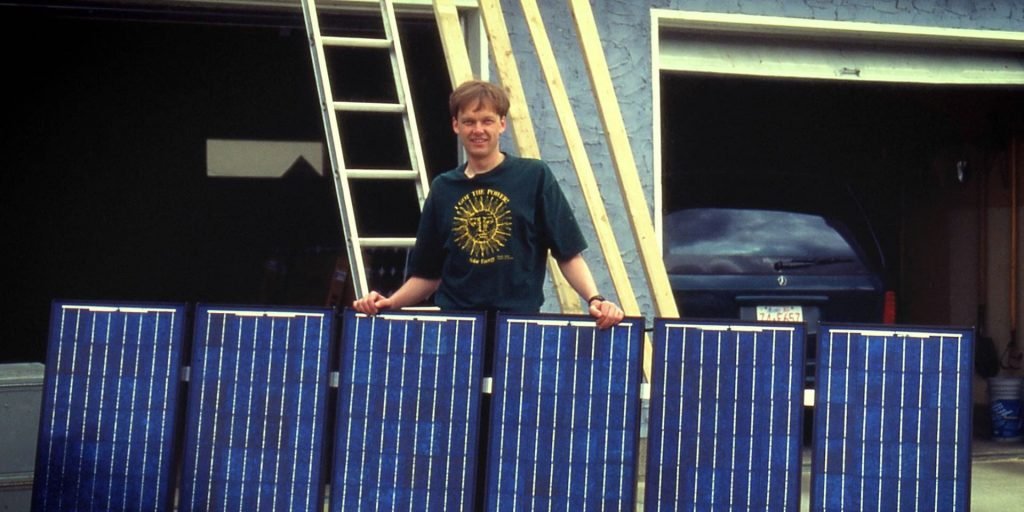
Working with Edmonton Power Gordon Howell installed the first grid-connected solar array in Western Canada in 1995 on his own home.
First grid connected solar system in the West
“In June 1994, Edmonton Power called me up out of the blue, and they were wanting to understand this technology.’”
The company said they were looking to do a project to learn about the barriers to connecting solar to the grid. “And I said, ‘Well, I’ve always wanted to put a solar electric system on the roof of my house, so that I can live and work with the technology I was consulting in.’ And they said, ‘Great, let’s do a project,’” says Gordon.
So Edmonton Power hired Gordon as a professional engineer to install a grid-connected solar electric system on his own roof, the first in Western Canada and the 12th in Canada.
Solar, a dance between your home and the grid
Solar systems are pretty simple, consisting of a solar array mounted on a south-facing roof. It harvests energy from sunshine to create DC electricity which is converted by an inverter into AC electricity and used by your home and your neighbours via the grid.
“It’s really fascinating because there’s this dance that happens between your house and the grid all the time. So at night, you’re using electricity from the grid, in the daytime you’re generating your own and if it’s a bright sunny day, you’re sending excess to the grid,” says Gordon. “Your meter gives the electricity company two numbers. One is used to give you a credit on your bill and the other one is used to give a charge on your bill.”
There is a certain elegance in the simplicity of solar energy. “There are no controls, there’s no noise. You don’t have to turn switches, you don’t hear anything, the electricity just goes where it goes,” says Gordon.
Gordon’s solar system is 2.3 kilowatts, initially enough to provide 40 per cent of his electricity, but after getting an energy efficient fridge and ditching an energy inefficient freezer he was able to provide all of his electricity from the small solar system.
Solar the leading clean energy technology in the world
Gordon’s solar system is still working today, the technology hasn’t changed much, but the price, that’s another story: “When I put the solar electric system on my own house it cost $40,000, and we could do the same system today for about $9,000.”
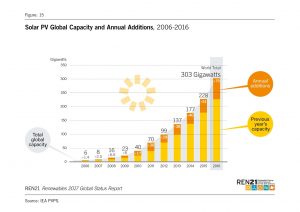
REN21 Renewables Global Status Report Source: http://www.ren21.net/status-of-renewables/global-status-report/renewables-2017-global-status-report-infographics/
And this explains why solar has become the leading clean technology in the world making up the largest single slice of the $287 billion global investment in clean energy in 2016. So far 303 gigawatts of solar have been installed in the world, that’s about one billion solar modules, enough the circle the globe 40 times if lined up end to end.
The City of Edmonton is also looking to solar as one way to achieve its energy transition goal of generating 10 per cent of electricity locally from renewable energy sources. And recently the city adopted a policy of dedicating one per cent of new capital construction budgets to on-site renewable energy. Solar capacity has doubled in Alberta since 2015 and new solar rebate programs offered by the province are expected to result in 5,000 – 10,000 new solar systems over the next two years.
“The International Energy Agency expects that by, 2030 or so, it’ll (solar) supply about a sixth of the world’s electricity,” says Gordon.
Want to go solar?
“Get a year’s worth of electricity bills together, add up all the kilowatt hours of energy that you use over the year,” says Gordon, and then talk to a reputable solar installer (see Solar Energy Society of Alberta). They will check out your home, the roof orientation, shading and other factors and provide you with a quote to power your home with solar.
The average home in Alberta uses 7,200 kilowatt hours of electricity.
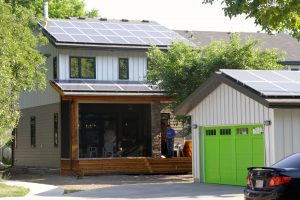
The average home in Edmonton would require a 6.3 kilowatt solar system to provide all of its electricity. Photo David Dodge, GreenEnergyFutures.ca
In Edmonton, Alberta this would mean a solar system of about 6.3 kilowatts, depending on your energy requirements. That will run between $17,000 and $19,000 and you can save about $4,700 off that price thanks to rebates.
Alberta has one of the best solar resources in Canada. A solar module here will produce almost 60 per cent more electricity than the same solar module in Hamburg, Germany.
Snow is not a problem either, since studies at NAIT in Edmonton have found losses of only five percent due to snow. Turns out solar modules love our cold climate.
Gordon Howell may have been the lonely solar guy in 1994, but he is about to have a lot of company. People are installing solar on their homes and businesses across the planet in record numbers.
We created this story from interviews done for the City of Edmonton’s Renewable video and blog series. Renewable is a series about visionaries, creators, community leaders and above all Edmontonians, each with a unique vision of a sustainable future in the heart of Canada’s fossil fuel industry.
